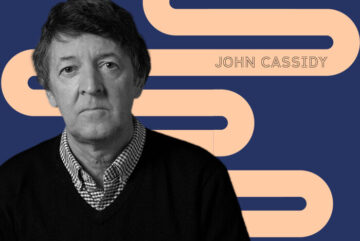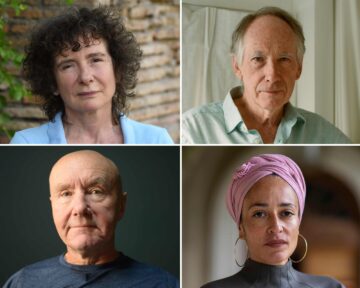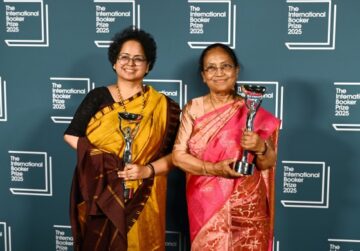Enjoying the content on 3QD? Help keep us going by donating now.
Category: Recommended Reading
Ancient Burials
Rebecca Batley at Aeon Magazine:
 To understand why early humans seemed to fear the dead, we first need to consider the long history of intentional burial. Only through excavated graves, makeshift tombs and other forms of interment can we begin making sense of prehistoric anxieties surrounding the dead. However, this history is not always straightforward: though we now have a rough idea of when burial became widespread, researchers are still vigorously debating exactly when humans began deliberately interring their dead.
To understand why early humans seemed to fear the dead, we first need to consider the long history of intentional burial. Only through excavated graves, makeshift tombs and other forms of interment can we begin making sense of prehistoric anxieties surrounding the dead. However, this history is not always straightforward: though we now have a rough idea of when burial became widespread, researchers are still vigorously debating exactly when humans began deliberately interring their dead.
One of the most controversial claims is that intentional burials may have been practised as early as 240,000 years ago by one of our hominin relatives, Homo naledi. This was proposed in 2023 after a team of researchers, led by the paleoanthropologist Lee Berger, found a minimum of 15 Homo naledi skeletons in the caverns of South Africa’s Rising Star cave system. The team claims that the excavated remains show ‘a consistent pattern of differentiation’ – that is, the bodies were intentionally buried. However, this interpretation has since been challenged by other archaeologists who argue that there is no sedimentological evidence showing that the burials were deliberate.
more here.
Enjoying the content on 3QD? Help keep us going by donating now.
On capitalism’s critics, why everyone is so unhappy with the system, and what may come next
James Surowiecki at The Yale Review:
 This is a pivotal moment for American capitalism. Even though GDP and household incomes have grown steadily in this century, most Americans say they feel dissatisfied with the state of the economy and believe that the country’s economic future will be worse than its past. There is a deep sense of discontent with capitalism, and a conviction that the two paradigms of political economy that have dominated the West since World War II—Keynesian social democracy on the one hand and free-market-centered neoliberalism on the other—no longer work. And while politicians like Bernie Sanders, with his left-wing populism, and Donald Trump, with his right-wing nationalism, have tapped into this discontent, what the new order will ultimately look like remains wholly unclear.
This is a pivotal moment for American capitalism. Even though GDP and household incomes have grown steadily in this century, most Americans say they feel dissatisfied with the state of the economy and believe that the country’s economic future will be worse than its past. There is a deep sense of discontent with capitalism, and a conviction that the two paradigms of political economy that have dominated the West since World War II—Keynesian social democracy on the one hand and free-market-centered neoliberalism on the other—no longer work. And while politicians like Bernie Sanders, with his left-wing populism, and Donald Trump, with his right-wing nationalism, have tapped into this discontent, what the new order will ultimately look like remains wholly unclear.
This is, then, a perfect moment for John Cassidy’s new book, Capitalism and Its Critics, which takes, as its title suggests, a wide-ranging look at the history of capitalism through the eyes of some of its foremost critics.
More here.
Enjoying the content on 3QD? Help keep us going by donating now.
Wednesday Poem
The Personal
I who have loved the personal
have fallen a bit out of love
with the personal.
I have never
owned a pair of slippers.
I recently realized my feet are cold.
I think I’ll buy slippers, I said
to myself and then my son,
over the phone, just for the sake
of conversation. I wasn’t asking
for his permission or anything.
Why do you want slippers? he asked.
I’m cold, I said. You’re cold?
What’s wrong with you? he asked.
like an accusation.
I don’t like it when you’re suddenly cold.
You sound like Ha-hoo, he said.
Ha-hoo was my grandmother.
I sent him a photo of some slippers
that didn’t seem too bad. They look
like Ha-hoo, he said. You’re
folding. You’re caving, he said.
Get this, he’s had slippers
for years. But I’m supposed to be
some sort of paragon. The slippers
I am maybe going to buy are the kind
that you can just your foot into.
Don’t get those, my son said.
You’ll fall down the stairs.
Thanks for the vote of confidence,
I said. He sent me a photo of some fake
moccasins lined with rabbit fur.
Get these he said.
You’ve got to be kidding me,
I said. He knew I’d reject them
for being appropriative. And think
of the poor rabbit. He was playing
mind games. He learned that from
his years on the streets.
I picture myself in a broken heap
at the bottom of the stairs.
Then I picture Ha-hoo skinning a rabbit.
Women back then had to have cold
hearts. James Joyce told me
the reason my milk wasn’t coming in
after I gave birth was because
I’d washed greens for what seemed
like hours with my hands in ice cold water.
Everybody knows ice water dries up
your supply, she said, like I was a factory
or something. I miss the days when I had
a grandmother and no one personalized
anything I did. I’d sit in her closet
and put pebbles in her high heels
and she never said a word. My feet
were like hot coals back then.
I could go outside in the winter
without shoes and with every step
the snow would hiss and melt.
If I had an insight, I’d keep it bottled up
until it disappeared, and I didn’t
have that many insights, Imagine
it. One pair of red shoes and no
slippers. My mind was empty
as a ballroom and I was not
compelled to dance.
by Diane Seuss
from Modern Poetry
Graywolf Press, 2024
Enjoying the content on 3QD? Help keep us going by donating now.
‘Turbocharged’ Mitochondria Power Birds’ Epic Migratory Journeys
Elizabeth Landau in Quanta Magazine:
 Weighing in at a single ounce, the white-crowned sparrow can fly 2,600 miles, from Mexico to Alaska, on its annual spring migration, sometimes traveling 300 miles in a single night. Arctic terns make even longer journeys of 10,000 miles and more from the Arctic Circle to Antarctica, while great snipes fly over food-poor deserts and seas, sometimes covering 4,200 miles in four days without stopping.
Weighing in at a single ounce, the white-crowned sparrow can fly 2,600 miles, from Mexico to Alaska, on its annual spring migration, sometimes traveling 300 miles in a single night. Arctic terns make even longer journeys of 10,000 miles and more from the Arctic Circle to Antarctica, while great snipes fly over food-poor deserts and seas, sometimes covering 4,200 miles in four days without stopping.
During migration season, many bird species become continent-spanning, high-endurance athletes. “They’re flapping their wings several times a second for up to eight hours at a time,” said Soren Coulson(opens a new tab), who studies migration physiology at the University of Memphis. For humans, an equivalent feat — say, running nonstop without food, water or rest for days at a time — would be unimaginable. “We were just amazed and interested in how can these birds fly for thousands of miles without stopping, at a really high intensity, when most of us can barely run a 5K,” said Paulo Mesquita(opens a new tab), who studies mitochondrial physiology and muscle aging at the Oklahoma Medical Research Foundation.
More here.
Enjoying the content on 3QD? Help keep us going by donating now.
New study finds ants can be trained to detect cancer
Enjoying the content on 3QD? Help keep us going by donating now.
Tuesday, June 3, 2025
Seamus Heaney, A Smiling Public Man
Jeffrey Meyers at Salmagundi:
 Seamus Heaney was born on April 13,1939 (12 days after me) and 3 months after the death of Yeats. The Letters* begin in 1965, his miraculous year. His first book, Death of a Naturalist, was accepted by Faber & Faber; he got a teaching job at his alma mater, Queen’s University in Belfast; and he married Marie Devlin, whom he was pleased to call Madame and Herself.
Seamus Heaney was born on April 13,1939 (12 days after me) and 3 months after the death of Yeats. The Letters* begin in 1965, his miraculous year. His first book, Death of a Naturalist, was accepted by Faber & Faber; he got a teaching job at his alma mater, Queen’s University in Belfast; and he married Marie Devlin, whom he was pleased to call Madame and Herself.
In September 1970 he began teaching at Berkeley, whose spectacular scenery and wild freedom were the polar opposite of dreary and repressed Belfast. He described the weirdness of Telegraph Avenue as if he’d landed on Mars: “[It’s] one of the most fantastic scenes you can imagine. Hippies, drop-outs, freak-outs, addicts, Black Panthers, Hare Krishna American kids with shaved heads, begging bowls and clothes made out of old lace curtains. …[It] has all the colour of the fairground and as much incense burning as a high altar in the Vatican. When I walk home from the campus I can almost hear the joss sticks frizzling in every apartment. The fragrant follies of lotos land.” He got into the act by growing his own wild mop of curly knots and heavy Victorian side whiskers.
He was unusually severe about the 42 students in his poetry writing course, who had more cheek than talent. Naming the three current gurus, he exclaimed that the class was “disastrous for the ego of most of them, stupid, illiterate, long-haired, hippie, Blake-ridden, Ginsberg-gullible…a lot of anxious and eager kids all wanting to hear they’re the greatest thing since, say, Charles Olson.”
More here.
Enjoying the content on 3QD? Help keep us going by donating now.
Our focus on recycling to save the planet may be missing the mark
Aissa Dearing at JSTOR Daily:
 “Reduce, reuse, recycle”: these three words have become as ubiquitous as the plastic waste they attempt to combat. Once seen as a simple roadmap toward sustainability, this mantra now conceals a far more complex and troubling reality. While these principles serve as a starting point for environmental action, they also have a deceptive history rooted in the petrochemical industry’s effort to avoid accountability. The truth is, no matter how diligently we sort our waste products, individual actions alone cannot solve the growing crisis of plastic pollution.
“Reduce, reuse, recycle”: these three words have become as ubiquitous as the plastic waste they attempt to combat. Once seen as a simple roadmap toward sustainability, this mantra now conceals a far more complex and troubling reality. While these principles serve as a starting point for environmental action, they also have a deceptive history rooted in the petrochemical industry’s effort to avoid accountability. The truth is, no matter how diligently we sort our waste products, individual actions alone cannot solve the growing crisis of plastic pollution.
The ubiquity of plastic in modern life makes recycling seem like a moral imperative. From straws and bags to take-out containers, single-use plastics crowd landfills and clog waterways. And the crisis is accelerating. Legal scholar Roberta Mann warns that by 2050, plastic in the ocean could outweigh fish. The United States led the world in plastic waste in 2016, Mann writes, generating over 42 million metric tons. The COVID-19 pandemic further fueled plastics consumption, with a spike in single-use personal protective equipment and packaging from online shopping.
But here’s the catch: research suggests that our dependence on recycling as a solution isn’t only ineffective—it’s based on a carefully crafted illusion.
More here.
Enjoying the content on 3QD? Help keep us going by donating now.
AI company’s CEO, Dario Amodei, issues warning about mass unemployment
Enjoying the content on 3QD? Help keep us going by donating now.
Zadie Smith and Ian McEwan among 380 writers and groups to call Gaza war ‘genocide’
Ella Creamer in The Guardian:
 Three hundred and eighty writers and organisations including Zadie Smith, Ian McEwan, Russell T Davies, Hanif Kureishi, Frank Cottrell-Boyce and George Monbiot have signed a letter stating that the Israeli government’s war in Gaza is genocidal and calling for an immediate ceasefire.
Three hundred and eighty writers and organisations including Zadie Smith, Ian McEwan, Russell T Davies, Hanif Kureishi, Frank Cottrell-Boyce and George Monbiot have signed a letter stating that the Israeli government’s war in Gaza is genocidal and calling for an immediate ceasefire.
“The use of the words ‘genocide’ or ‘acts of genocide’ to describe what is happening in Gaza is no longer debated by international legal experts or human rights organizations,” reads the letter, which was also signed by William Dalrymple, Jeanette Winterson, Brian Eno, Kate Mosse, Irvine Welsh and Elif Shafak.
Organisations including Amnesty International, Human Rights Watch and the United Nations human rights council have “clearly identified” acts of genocide enacted by the Israeli Defense Forces (IDF), the letter says, while public statements by the Israeli ministers Bezalel Smotrich and Itamar Ben-Gvir “openly express genocidal intentions”.
More here.
Enjoying the content on 3QD? Help keep us going by donating now.
Elon Musk’s Black-Eyed Exit & Trump’s Insane New Biden Conspiracy
Enjoying the content on 3QD? Help keep us going by donating now.
‘Mountainhead’ Review: While We Go Down, They Bro Down
James Poniewozik in The New York Times:
 Imagine being stuck in a room with Roman Roy — Kieran Culkin’s witty, self-hating “Succession” character — without having gotten any understanding of his psyche to contextualize his machine-gun quips. That’s “Mountainhead,” times four. No one here reveals much of themselves beyond their first, worst impression, with the exception of Youssef’s Jeff, who is — unusually for an Armstrong protagonist — decent but boring.
Imagine being stuck in a room with Roman Roy — Kieran Culkin’s witty, self-hating “Succession” character — without having gotten any understanding of his psyche to contextualize his machine-gun quips. That’s “Mountainhead,” times four. No one here reveals much of themselves beyond their first, worst impression, with the exception of Youssef’s Jeff, who is — unusually for an Armstrong protagonist — decent but boring.
Still, what “Mountainhead” lacks in depth, it makes up for in satirical daring. Armstrong’s hallmarks are present: a brutal sense of interpersonal power dynamics, a flair for creative profanity, an abiding belief that the worst people will succeed. If “Mountainhead” is one-note, that note is a piercing one: Armstrong takes the tech-lord principle of “accelerationism” — floor the pedal on change and damn the consequences for the little people — to a chilling conclusion. When you’re perched on top of the world, the film argues, acceleration takes you straight downhill.
More here.
Enjoying the content on 3QD? Help keep us going by donating now.
Tuesday Poem
………………………………….Names Lost in the Count
………………………………………………………
The world speaks in digits now.
Death now serves as ornament for the news headlines.
Human flesh, scratched to cold numbers.
Corpses now subjected to fatuous calculations.
each name a footnote in an endless spreadsheet that tires a human eye.
an algebra of annihilation.
silence.
the tombs without epitaphs as its roots.
(To the people of Palestine)
Enjoying the content on 3QD? Help keep us going by donating now.
Monday, June 2, 2025
Remembering Alasdair MacIntyre
Charles Mathewes in The Hedgehog Review:
 The first time I met Alasdair MacIntyre I was twenty-one, and he threatened to kill one of my classmates. Then he told us all that our attention to his work was “profoundly misbegotten.” It was the spring semester of 1991, my senior year at Georgetown University, and my capstone seminar was dedicated to reading everything the Scottish-born philosopher had written up to that point. (It was a lot.) At the end of the semester, he came for a full day of discussion. To call it “vigorous” and “frank” would suggest we were auditioning for the State Department.
The first time I met Alasdair MacIntyre I was twenty-one, and he threatened to kill one of my classmates. Then he told us all that our attention to his work was “profoundly misbegotten.” It was the spring semester of 1991, my senior year at Georgetown University, and my capstone seminar was dedicated to reading everything the Scottish-born philosopher had written up to that point. (It was a lot.) At the end of the semester, he came for a full day of discussion. To call it “vigorous” and “frank” would suggest we were auditioning for the State Department.
As I recall, he mocked those who did not like the Red Sox (or possibly those who did?). At another point, he suggested that, if we were in Ireland, he would have been entitled to kill one of my classmates. Undoubtedly, though, the most memorable moment for me came at lunch, when one of us asked him a question that was really a barely disguised invitation for him to congratulate us on our class’s dedication to his writings. He was having none of it. “Oh, I think your class is profoundly misbegotten,” he said. “If you had understood anything of what I have written, you would have immediately stopped reading my work and turned to an intensive study of Aristotle and Aquinas.”
Today these sorts of things would, shall we say, not go well as pedagogically acceptable methods of interacting with students. But we knew how to take it—that is, not personally—and so instead of being offended or feeling threatened, we learned.
More here.
Enjoying the content on 3QD? Help keep us going by donating now.
Nudging, attracting, and coercing capital towards decarbonization
Leah Downey and Mark Blyth at Taylor and Francis Online:
 How should states secure funding to support the green transformation, where the state is an actor that is both public and dependent upon private interests? This pressing issue in international political economy (IPE) has so far generated different and dissonant scholarly discussion. This special issue brings analytic and empirical specificity to these conversations in order to map out the possible macrofinancial strategies that states have open to them. We contend that there are three possible policy strategies that states can adopt, albeit with some degree of combination or overlap. The first strategy embraces macrofinancial policies that attempt to ‘nudge’ agents into specific behaviors and/or rely on market signals as the primary drivers in delivering decarbonisation. The second strategy is one of attracting investment from the holders of existing assets through financial incentives, which is what the existing literature most often refers to as ‘derisking’ The third strategy we identify is ‘strengthening the state’ or, more bluntly, coercing private finance into investing, or bypassing them completely. The authors in this special issue ask what the limitations of each strategy are in specific national contexts, and what the coalitional and distributional consequences would be of embracing these policies that nudge, attract, or coerce.
How should states secure funding to support the green transformation, where the state is an actor that is both public and dependent upon private interests? This pressing issue in international political economy (IPE) has so far generated different and dissonant scholarly discussion. This special issue brings analytic and empirical specificity to these conversations in order to map out the possible macrofinancial strategies that states have open to them. We contend that there are three possible policy strategies that states can adopt, albeit with some degree of combination or overlap. The first strategy embraces macrofinancial policies that attempt to ‘nudge’ agents into specific behaviors and/or rely on market signals as the primary drivers in delivering decarbonisation. The second strategy is one of attracting investment from the holders of existing assets through financial incentives, which is what the existing literature most often refers to as ‘derisking’ The third strategy we identify is ‘strengthening the state’ or, more bluntly, coercing private finance into investing, or bypassing them completely. The authors in this special issue ask what the limitations of each strategy are in specific national contexts, and what the coalitional and distributional consequences would be of embracing these policies that nudge, attract, or coerce.
More here.
Enjoying the content on 3QD? Help keep us going by donating now.
AI pioneer Dr. Fei-Fei Li discusses ethical development of artificial intelligence
Enjoying the content on 3QD? Help keep us going by donating now.
A cure for individualism
Tim Connolly at Aeon:
 In the modern West, individualism takes on many forms. Perhaps the most readily apparent is in a political philosophy that puts the freedom and the rights of individuals as its highest values. The social contract theory of Thomas Hobbes and John Locke treats society as originating from an agreement of free, self-interested persons, in which government exists for the purpose of securing individual rights. These views are also reflected in an economic system that encourages individual innovation in the pursuit of wealth, and treats private property as sacrosanct.
In the modern West, individualism takes on many forms. Perhaps the most readily apparent is in a political philosophy that puts the freedom and the rights of individuals as its highest values. The social contract theory of Thomas Hobbes and John Locke treats society as originating from an agreement of free, self-interested persons, in which government exists for the purpose of securing individual rights. These views are also reflected in an economic system that encourages individual innovation in the pursuit of wealth, and treats private property as sacrosanct.
But individualism runs deeper than politics and economics, pervading our very notion of who we are. In the United States, the view that every individual is unique is held by Christians who believe each person is created in the image and likeness of God, as well as by secularists who believe that people should be free to determine their own identities, regardless of traditional norms. From an early age, children raised in individualistic societies are encouraged to follow their passions, make their own choices, and express who they are. They are instilled with values like self-reliance, ambition and personal responsibility.
Even when we criticise individualism, we remain entrenched in individualist modes of thinking.
More here.
Enjoying the content on 3QD? Help keep us going by donating now.
Howard Eiland: Walter Benjamin – A Critical Life
Enjoying the content on 3QD? Help keep us going by donating now.
Benjamin And The Angel Of History
Lawrence Weschler at Wondercabinet:
 My recent fortnight in Berlin was replete with its usual share of artwalk splendors—the permanent display of room after room of paintings by the incomparable Adolph Menzel at the Alte Nationalgalerie (though actually not so incomparable as all that, Michael Fried in his book on the artist has suggested that Menzel was one of the three great masters of nineteenth century realism, being to Prussia what Courbet was to France and Eakins to the United States, which seems about right to me), and then opening night of the rapturous and rollicking retrospective of the Brazilian midcentury modernist Lygia Clark at the Neue Nationalgalerie—but for my money, the most surprising and splendid revelation and my own nominee for this month’s International Best in Show, was a little one-room jewelbox of an exhibit tucked into a side alcove at the Bode Museum at the very tip of the city’s Museuminsel. Focusing on Walter Benjamin and the Angel of History, it was presented as the museum’s contribution to the citywide commemoration of the 80th anniversary of the end of the Second World War this past May, and under the exquisite curation of Neville Rowley, launched out from an evocation of the eminent Berlin flaneur/philosopher/historian/critic/theorist/rhapsode’s curious fascination with a tiny painting by his friend Paul Klee, which he himself owned, carrying it with him wherever he went into exile after 1933, though hiding it in the vaults of Paris’s Bibliotheque National alongside some final manuscripts, just as he was leaving there in 1940, with instructions that, should he himself not make it out alive, which as we know, tragically, he did not, the pieces should be passed along to his friend since childhood, the great Palestine-based historian of Kaballah, Gershom Scholem. (Scholem himself eventually contributed the Klee to the Israel Museum in Jerusalem, from which it is on rare loan to this show.)
My recent fortnight in Berlin was replete with its usual share of artwalk splendors—the permanent display of room after room of paintings by the incomparable Adolph Menzel at the Alte Nationalgalerie (though actually not so incomparable as all that, Michael Fried in his book on the artist has suggested that Menzel was one of the three great masters of nineteenth century realism, being to Prussia what Courbet was to France and Eakins to the United States, which seems about right to me), and then opening night of the rapturous and rollicking retrospective of the Brazilian midcentury modernist Lygia Clark at the Neue Nationalgalerie—but for my money, the most surprising and splendid revelation and my own nominee for this month’s International Best in Show, was a little one-room jewelbox of an exhibit tucked into a side alcove at the Bode Museum at the very tip of the city’s Museuminsel. Focusing on Walter Benjamin and the Angel of History, it was presented as the museum’s contribution to the citywide commemoration of the 80th anniversary of the end of the Second World War this past May, and under the exquisite curation of Neville Rowley, launched out from an evocation of the eminent Berlin flaneur/philosopher/historian/critic/theorist/rhapsode’s curious fascination with a tiny painting by his friend Paul Klee, which he himself owned, carrying it with him wherever he went into exile after 1933, though hiding it in the vaults of Paris’s Bibliotheque National alongside some final manuscripts, just as he was leaving there in 1940, with instructions that, should he himself not make it out alive, which as we know, tragically, he did not, the pieces should be passed along to his friend since childhood, the great Palestine-based historian of Kaballah, Gershom Scholem. (Scholem himself eventually contributed the Klee to the Israel Museum in Jerusalem, from which it is on rare loan to this show.)
more here.
Enjoying the content on 3QD? Help keep us going by donating now.
Red Lungi
Banu Mushtaq in Paris Review:
 There’s no end to the woes that mothers face come summer vacation. All the children are at home. When they’re not in front of the TV, they’re either climbing the guava tree in the front yard or perched on the compound wall. What if one of them falls and breaks an arm or a leg? Then there’s the crying, the laughter, the punishments they inflict on one another based on some arcane system of justice … This was why Razia’s headaches worsened when the summer holidays started. The nerves in her temples throbbed, her hot head felt like it would burst, and it seemed as if the veins at the back of her neck might snap at any moment. One after the other the children rushed in with their complaints, crying and screaming … and then there were their games … abbabbaa … battles with swords and machine guns, bomb attacks … !
There’s no end to the woes that mothers face come summer vacation. All the children are at home. When they’re not in front of the TV, they’re either climbing the guava tree in the front yard or perched on the compound wall. What if one of them falls and breaks an arm or a leg? Then there’s the crying, the laughter, the punishments they inflict on one another based on some arcane system of justice … This was why Razia’s headaches worsened when the summer holidays started. The nerves in her temples throbbed, her hot head felt like it would burst, and it seemed as if the veins at the back of her neck might snap at any moment. One after the other the children rushed in with their complaints, crying and screaming … and then there were their games … abbabbaa … battles with swords and machine guns, bomb attacks … !
Enough is enough, she thought, and lay on the divan cot in the hall with a piece of cloth wound tightly around her head. She couldn’t bear the noise. The TV was on, though at a low volume. She had warned the children sternly, and was just beginning to hope that she could finally relax and put her feet up when one of them wailed, “Doddammaaa … Doddamma, she’s pinching me!” Fuming, Razia jumped to her feet, silently cursing them.
More here.
Enjoying the content on 3QD? Help keep us going by donating now.
